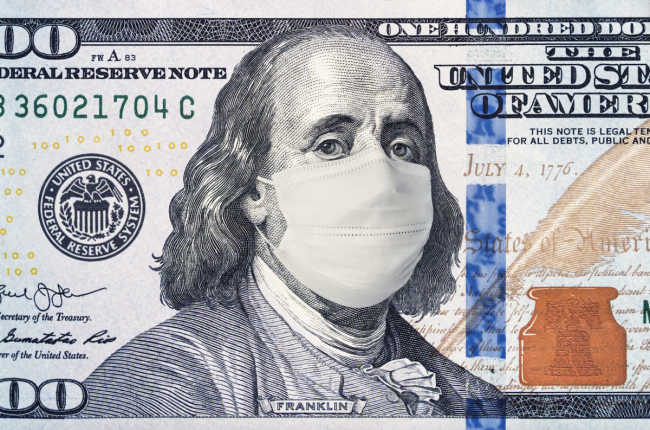You have /5 articles left.
Sign up for a free account or log in.

Diy13/iStock/Getty Images Plus
Average faculty pay fell by 0.4 percent this year, adjusting for inflation, the first such decrease since 2011-12, according to preliminary data from the American Association of University Professors’ annual Faculty Compensation Survey.
This top-line figure doesn’t tell the full story of how academic salaries have fared during COVID-19. Just as the pandemic has had an outsize effect on certain parts of society and the economy, it’s affected faculty compensation at certain kinds of institutions, at certain ranks, more than others.
Faculty compensation data don’t show what isn’t there, either. Some institutions’ faculty compensation figures actually increased this year over last simply because they laid off some of their lowest-paid professors during the pandemic.
Of course, faculty compensation isn’t just about salaries. Many institutions reduced or cut fringe benefits this year. And it’s unclear when or whether some of these colleges and universities will restore them.
“There were those [institutions] that were already in financial trouble,” said Glenn Colby, senior researcher at the AAUP. “And in those cases, they cut fringe benefits for salaries and let people go -- didn't renew contracts of non-tenure-track people and things like that. And I think it's going to be worse in the fall.”
Faculty Ranks Shrink, as Does Faculty Pay -- and Who Makes More, Where
Already, full-time faculty numbers fell at more than half of institutions, year over year. At 26 percent of institutions, the number of full-time faculty members fell by at least 5 percent. Doctoral institutions were least affected, seeing a small growth in full-time faculty ranks. But full-time faculty numbers fell 2.2 percent at master’s institutions, 1.6 percent at four-year institutions and 3.1 percent at community colleges.
The number of full-time faculty members increased slightly at public institutions and dropped elsewhere, most of all -- by 2.4 percent -- at private, religiously affiliated colleges and universities.
Professor pay decreased at two-thirds of colleges and universities, adjusted for inflation. Wage growth for full-time professors in 2020-21 was the lowest since the AAUP began tracking this growth in 1972.
Average faculty salaries decreased at 42 percent of colleges and universities surveyed. Real wage growth decreased at 68 percent of colleges and universities, after adjusting for inflation.
At doctoral institutions, on average, assistant professors made $91,408 this academic year. Associate professors made $104,482. And full professors made $159,919. Full-time instructors, meanwhile, made $66,620. Lecturers made $69,295.
Full professors at master’s degree-granting institutions made $104,389, associate professors made $83,958 and assistant professors made $73,492. Full-time instructors made $57,103. Salaries were roughly parallel at baccalaureate institutions.
At community colleges, full professors made $91,196, associates made $75,550 and assistants made $64,823. Instructors and lecturers made $54,547 and $68,641, respectively.
Pay at secular private institutions tended to be better than at public institutions, but publics tended to pay more than religiously affiliated colleges and universities.
As in years past, the AAUP found a gender gap between men and women, and not just at the full professor ranks. Across academe, across institution types, male full professors made $147,042 this year and female full professors made $127,819. Among assistant professors, men and women were paid $87,530 and $79,621, respectively. Male lecturers were paid $69,857 and women $64,187. The AAUP doesn't break down salaries by discipline.
Salaries also varied by geographical region, as they always do, with institutions paying the most in New England, the Mid-Atlantic and on the West Coast. The average assistant professor in New England made about $93,000 this year, while the average assistant professor in the lowest-paid region, including Alabama, Kentucky, Mississippi and Tennessee, made about $74,000.
Not adjusting for inflation, average salaries increased 1 percent year. This is the smallest increase on record since the AAUP began tracking this measure in 1972.
At doctoral institutions, average salaries increased 0.6 percent. After adjusting for inflation, they decreased 0.8 percent.
At master’s and baccalaureate institutions, average salaries increased 0.8 percent and 0.1 percent, respectively. After adjusting for inflation, real wages decreased 0.6 percent and 1.3 percent, respectively.
At associate degree-granting institutions with faculty ranking systems, average salaries increased 1.7 percent, an increase of 0.3 percent in real terms. But at community colleges without faculty ranking systems, average salaries decreased 2.7 percent, or 4.1 percent considering inflation.
Average faculty salaries increased 1.1 percent among public and private, religiously affiliated colleges and universities. They increased by 0.2 percent at private independent institutions.
COVID-19 and the Faculty
The AAUP surveys institutions every year on faculty compensation and other data. This year, it asked additional questions about how colleges and universities responded to the financial pressures of COVID-19. Some 5 percent said they did not reappoint or had terminated contracts for at least some tenured or tenure-track faculty members. Some 20 percent did not renew contracts or terminated contracts for at least some non-tenure-track professors.
Just about 10 percent of colleges and universities adopted furloughs for at least some instructors. More than half of institutions took some other measure regarding tenured and tenure-track professors, the most common of which was offering some type of early retirement program.
The AAUP is releasing its more detailed Annual Report on the Economic Status of the Profession next month. Unfortunately, the major analysis of part-time faculty compensation during COVID-19 will have to wait until next year, as institutions don’t typically release per-course pay and other information until the end of the academic year.
While academe barely kept pace with inflation this year, faculty salaries did fare better than some other parts of the economy during COVID-19. Asked about this, Colby said critics sometimes argue that it’s acceptable to have nominal wage growth on par with the inflation rate. But he said that argument ignores issues of productivity, which the Federal Reserve has assumed to be about 1.5 to 2 percent annual growth in general -- on top of the 2 percent inflation target.
While Colby cautioned against confusing productivity issues with workload issues, productivity expectations for academics had been creeping skyward prior to COVID-19, and the pandemic swelled their workloads.
Ultimately, Colby said, “continued flat wage growth places institutions at risk of losing talented faculty members,” in some fields to better-paying jobs outside higher education.
Highest-Paying Institutions -- and a Big Asterisk
For many years, Inside Higher Ed has highlighted the highest-paying institutions included in AAUP’s report due to reader interest. This salary information is not meant to be representative of what the average faculty member makes. And it doesn’t necessarily mean that these institutions pay their part-time faculty members similarly well, or that they even release their per-course pay data to the AAUP (some don’t).
Colby said, for instance, that full professors at the most research-active universities represent about 5 percent of faculty members across all degree-granting institutions. And the 6,703 highest-paid full professors at private institutions represent just half of 1 percent of all professors, he said.
With that major disclaimer in mind, here are the highest-paying individual institutions this year, by category.
Top Salaries for Full Professors at Private Universities, 2020-21 (Average)
|
1 |
Columbia University |
$280,800 |
|
2 |
Stanford University |
$260,100 |
|
3 |
Princeton University |
$257,600 |
|
4 |
Harvard University |
$254,900 |
|
5 |
University of Chicago |
$251,100 |
|
6 |
Massachusetts Institute of Technology |
$239,500 |
|
7 |
University of Pennsylvania |
$236,800 |
|
8 |
Yale University |
$234,300 |
|
9 |
Duke University |
$220,600 |
|
10 |
Northwestern University |
$217,100 |
Top Salaries for Full Professors at Public Universities, 2020-21 (Average)
|
1 |
University of California, Los Angeles |
$234,200 |
|
2 |
University of California, Berkeley |
$214,300 |
|
3 |
University of California, Santa Barbara |
$203,800 |
|
4 |
University of California, San Diego |
$202,600 |
|
5 |
University of California, Irvine |
$192,100 |
|
6 |
Rutgers University-Newark |
$191,600 |
|
7 |
University of Texas at Austin |
$188,600 |
|
8 |
University of Virginia |
$187,700 |
|
9 |
New Jersey Institute of Technology |
$185,400 |
|
10 |
University of California, Davis |
$183,400 |
Top Salaries for Full Professors at Liberal Arts Colleges, 2020-21 (Average)
|
1 |
Barnard College |
$176,800 |
|
2 |
Claremont McKenna College |
$176,100 |
|
3 |
University of Richmond |
$161,900 |
|
4 |
Pomona College |
$160,500 |
|
5 |
Wellesley College |
$159,600 |
|
6 |
Wesleyan University |
$158,500 |
|
7 |
Swarthmore College |
$156,300 |
|
8 |
Amherst College |
$155,800 |
|
9 |
Harvey Mudd College |
$154,600 |
|
10 |
Colgate University |
$151,700 |
|
11 |
Bard College |
$151,600 |
|
12 |
Williams College |
$149,900 |
|
13 |
Bowdoin College |
$146,900 |
|
14 |
Scripps College |
$146,300 |
|
15 |
Colby College |
$146,000 |
|
16 |
United States Naval Academy |
$144,800 |
|
17 |
Bryn Mawr College |
$144,400 |
|
18 |
Washington and Lee University |
$143,900 |
|
19 |
Vassar College |
$142,800 |
|
20 |
Hamilton College |
$142,100 |
Top Salaries for Assistant Professors at Colleges and Universities, 2020-21 (Average)
|
1 |
Columbia University |
$152,704 |
|
2 |
University of Pennsylvania |
$140,320 |
|
3 |
Harvard University |
$139,691 |
|
4 |
Babson College |
$138,022 |
|
5 |
Massachusetts Institute of Technology |
$137,757 |
|
6 |
California Institute of Technology |
$136,475 |
|
7 |
Stanford University |
$136,035 |
|
8 |
University of Chicago |
$130,375 |
|
9 |
Bentley University |
$128,319 |
|
10 |
Princeton University |
$124,204 |









